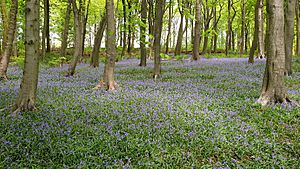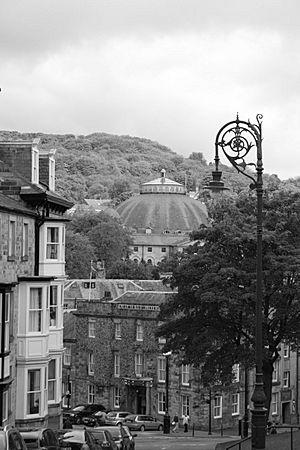Corbar Hill facts for kids
Quick facts for kids Corbar Hill |
|
|---|---|

Corbar Hill at dusk
|
|
| Highest point | |
| Elevation | 437 metres (1,434 ft) |
| Geography | |
| Location | Peak District, England |
| OS grid | SK 051743 |
| Topo map | OS Explorer OL24 |
Corbar Hill is a beautiful sandstone hill located in the Peak District in Derbyshire, England. It stands tall overlooking the town of Buxton. The very top of the hill, marked by a special pillar, is about 437 meters (1,434 feet) above sea level. It's a great spot for exploring nature and enjoying views.
Contents
Exploring Corbar Hill's Open Spaces
Much of Corbar Hill, along with nearby Combs Moss and Black Edge, is considered "open access" land. This means people can freely walk and explore these areas. This right was given to the public by a law called the Countryside and Rights of Way Act 2000. It helps everyone enjoy the beautiful English countryside.
The Story of Corbar Cross
At the very top of Corbar Hill, you'll find a large cross known as Corbar Cross. The Duke of Devonshire gave this cross to the Catholic community in Buxton. They put it up in 1950 to celebrate a special time called the Holy Year, announced by Pope Pius XII.
Over the years, the cross has had an interesting history. In the 1990s, it was painted pink as a joke. Later, in 2010, the cross was damaged. A new, strong cross made of solid oak was donated by a company from Lancashire. This new cross is about 6 meters (20 feet) tall and was put in place in 2011.
Discovering Corbar Woods
Corbar Woods is a very old forest in Buxton. It's part of a special area called "The Park" conservation area. The Buxton Civic Association owns and takes care of these 54 acres of woods.
A Look at Ancient Uses
Long ago, in medieval times, people used Corbar Woods for a practice called coppicing. This meant cutting trees in a way that allowed them to grow back. There are also signs of an old "white coal pit" in the woods. This pit used dried coppiced branches to create very hot fires. These fires were needed to melt lead, which was an important activity in the area.
Walking the Victorian Swiss Paths
In the 1800s, special paths were built through these ancient woods. They are known as the Victorian Swiss Walks. A famous designer named Joseph Paxton created these paths. He also designed the original Buxton Pavilion Gardens. These paths allowed visitors to Buxton, a popular spa town, to enjoy amazing views of the town's grand buildings from the hilltop.
Today, a marked walking trail called the "Ring of Trees" goes through Corbar Wood. It's a great way to explore the area.
Plants and Animals of the Woods
The main types of trees you'll see in Corbar Woods are beech, yew, and oak. In May, the ground at the higher, western part of the woods is covered with beautiful bluebells.
The woods are home to many common birds like thrushes, tits, and finches. You might also spot nuthatches and woodpeckers, which are special birds that live in forests.
Buildings Around Corbar Hill
Corbar Hill is also home to some interesting buildings with long histories.
Corbar Hill House
Corbar Hill House is a historic building located on Corbar Road in Buxton. It is listed as a Grade II listed building, meaning it's important and protected. It was built in the 1800s and looks like a French château, with a special roof and a fountain. It was built for the Ryder family.
Later, this house became the John Duncan School, which closed in 2003. Now, it has been changed into private apartments where people live.
Corbar Hill Hydro
The Corbar Hill Hydro was once a guest house called the Clarendon. In the 1890s, it was changed to offer hydropathic treatments. These were water-based therapies for health. In the 1930s, it was sold and used as housing for nurses.
Nithen Quarry: A Source of Stone
Nithen Quarry is a quarry on Corbar Hill. For many years, it was an important source of high-quality sandstone. This sandstone was used to build many of Buxton's buildings. For example, the town hall, which was built in the 1890s, was made using stone from Nithen Quarry.



